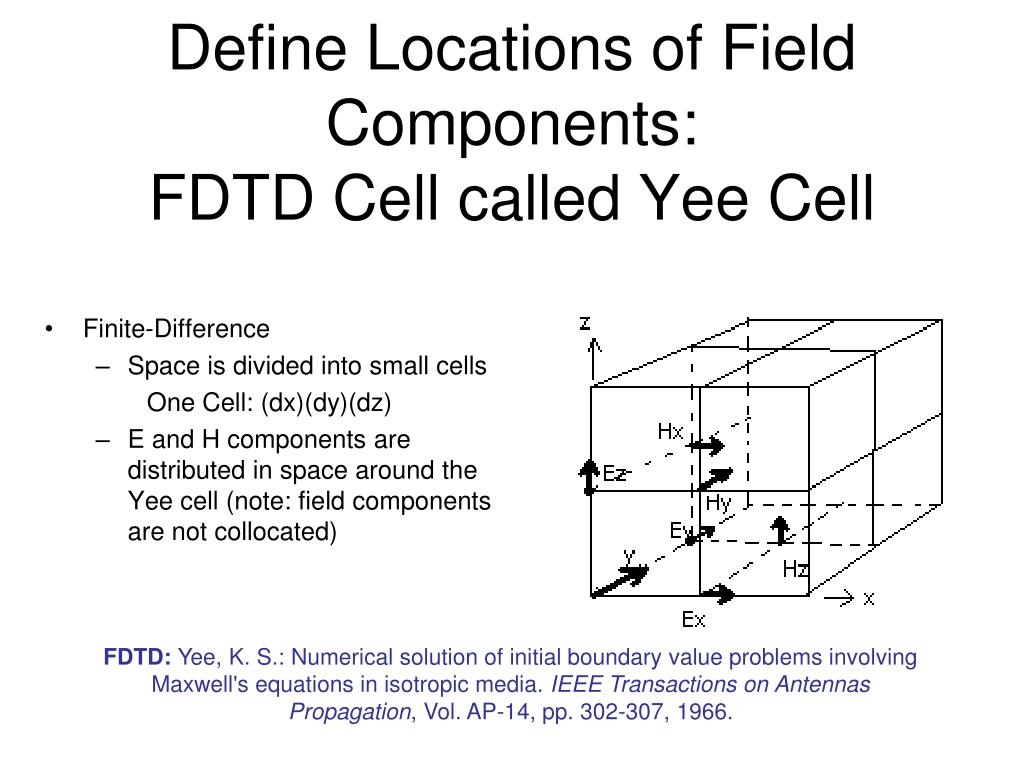
In the 2D TM case (E x, H y, E z - nonzero components, propagation along Z, The time step is determined by the Courant limit: The sampling in time is selected to ensure numerical stability of the algorithm. Typically, 10 to 20 steps per wavelength are needed. The sampling in space is on a sub-wavelength scale.

It uses central difference approximations for the numerical derivatives in space and time, both having second order accuracy. This is the so-called Yee’s numerical scheme applied to the 2D TE case. The superscript n labels the time steps while the indices i and k label the space steps and Δx and Δz along the x and z directions, respectively. The total set of numerical Equation 1 takes the form: The numerical analog inĮquation 1 can be derived from the following relation: The H zįield is associated with (i + 0.5) and integer k indices. The H x field is associated with integer i and (k + 0.5) indices. The locations of the electric fields are associated with integer values of the The magnetic fields H x and H z are associated withĬell edges. The E y field is considered to be the center of the FDTD space cell.

In Figure 2, the solid lines represent the mesh given The TE fields stencil can be explained as follows. The fields in the mesh is shown in Figure 2.įigure 2: Location of the TE fields in the computational domain Space steps in the X and Z direction, respectively. The indices i and k account for the number of The refractive index is n = √ε r.Įach field is represented by a 2D array - E y(i,k), H x(i,k) and H z(i,k) - corresponding Where ε = ε 0ε r is the dielectric permittivity and is the magnetic permeability of In the 2D TE case (H x, E y, H z – nonzero components, propagation along Z, transverseįield variations along X) in lossless media, Maxwell’s equations take the following Each mesh point is associated with a specific type of material and contains information about its properties such as refractive index, and dispersion parameters.įigure 1: Numerical representation of the 2D computational domain TE waves The space steps in the X and Zĭirections are Δx and Δy, respectively. The 2D computational domain is shown in Figure 1. This assumption removes all the ∂/ ∂ y derivatives from Maxwell’sĮquations and splits them into two (TE and TM) independent sets of equations. The Y-direction is assumed toīe infinite. The FDTD approach is based on a direct numerical solution of the time-dependent Semiconductors) to be used in a typical device design. A sub-micron scale implies a high degree of light confinement andĬorrespondingly, the large refractive index difference of the materials (mostly Powerful simulation and analysis of sub-micron devices with very fine structuralĭetails. It can also model materialĪnisotropy and dispersion without any pre-assumption of field behavior such as the

This is due to its uniqueĬombination of features, such as the ability to model light propagation, scattering andĭiffraction, and reflection and polarization effects. Tool for integrated and diffractive optics device simulations. The FDTD method has been established as a powerful engineering
FDTD SOLUTION SOFTWARE
The OptiFDTD software package is based on the finite-difference time-domain OptiFDTD is a powerful, highly integrated, user-friendly software that allows computerĪided design and simulation of advanced passive photonic components.


 0 kommentar(er)
0 kommentar(er)
